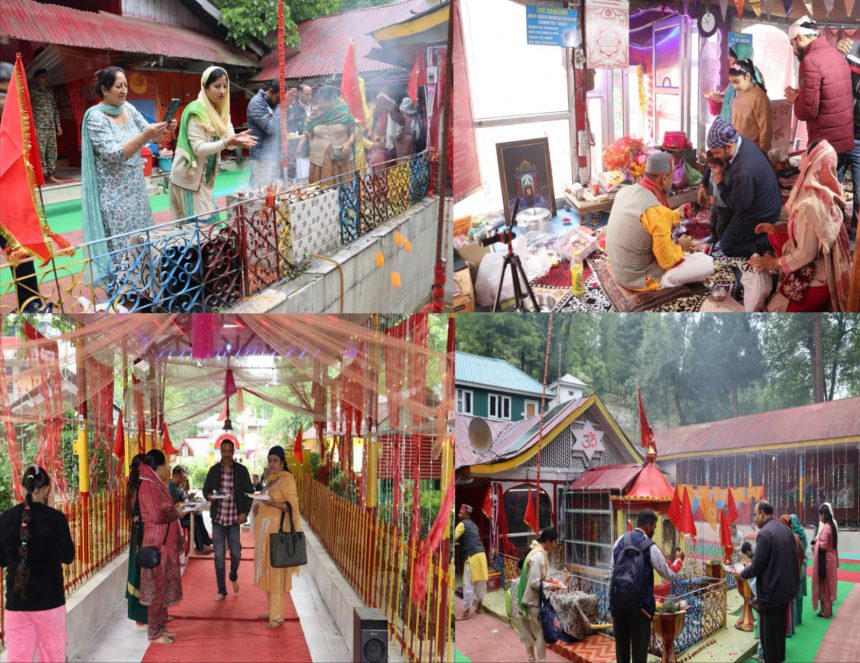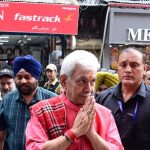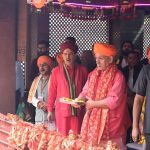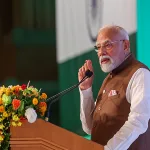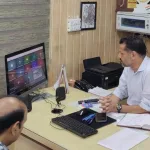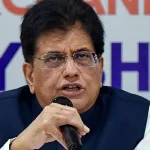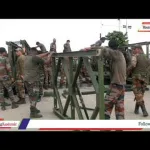Ganderbal, June 03: Amid tight security and the devotional rhythm of bhajans echoing through the sacred precincts, the annual Mela Kheer Bhawani was celebrated with deep spiritual fervour and moving displays of communal harmony at the historic Mata Kheer Bhawani temple in central Kashmir’s Tullamulla.
Thousands of devotees, many of them visiting after decades, offered prayers to Goddess Ragniya Devi, revered as the kuldevi (family deity) of Kashmiri Pandits. The atmosphere was both joyous and tearful, as families reunited and long-lost bonds between Pandits and local Muslims were reaffirmed with warm embraces, shared memories, and gestures of mutual respect.
For many devotees, the pilgrimage was deeply personal. “It was my childhood dream to pay obeisance here,” said a tearful first-time visitor. “The welcome we received from our Muslim brothers and sisters was overwhelming. It felt like home.”
Poorna Pandita, 50, described the fair as a cultural lifeline. “It’s not just about worship. It’s about seeing faces we thought we’d lost to time and turmoil.”
Local Muslims, as in years past, played an instrumental role in the event. From arranging flowers and milk for rituals to managing logistics for incoming devotees, their quiet support underscored Kashmir’s long history of interfaith harmony.
Sita Devi, a devotee who has attended the mela for two decades, acknowledged this support: “They’ve never let us feel like outsiders. Their care for our traditions is genuine and deeply touching.”
“Faith will always trump fear,” said an 80-year-old devotee who has been attending the Mela for over two decades. “We cannot let terror decide our traditions. This is not just a festival; it’s a sacred reunion with our deity, our roots, and our land.”
The Kheer Bhawani Mela, dedicated to the goddess Ragnya Devi—fondly known as Mata Kheer Bhawani—is one of the most significant spiritual events for the Kashmiri Pandit community. This year’s celebration, held under the canopy of centuries-old chinar trees, carried added emotional weight.
How could we possibly skip this festival?” exclaimed Ramesh, another devotee. “Our devotion to Mata runs deep—she is our Kul Devi. Visiting her shrine is not just a tradition, it’s a sacred responsibility. We’re not afraid—this is our homeland. Yes, incidents occur, but the security and arrangements are commendable. I encourage everyone to come and receive her blessings.”
For many who have returned—particularly those who fled the Valley during the 1990 migration—the pilgrimage represents far more than a religious practice; it’s a heartfelt homecoming. “I left the Valley in 1990,” shared Ashok Bhat. “To return and offer prayers beneath the same chinar trees is like stepping back into my childhood.
Nearby, Muslim shopkeepers offered sweets, water, and assistance with quiet pride. “This isn’t just about business. It’s our shared heritage,” said a vendor who’s operated near the shrine for over 15 years.
The event was held under heightened security arrangements in the wake of Operation Sindoor, with officials noting that over 200 checkpoints had been established across the district to ensure a safe pilgrimage.
Senior security officers said the success of the event reflected the improving situation on the ground and the return of faith among the people — not just religious, but civic and social. As thousands of lamps were lit and chants filled the air, what stood out was not just the religious devotion, but the emotional healing taking place.
“This is the Kashmir we remember. This is the Kashmir we want our children to know,” said a tearful elderly Pandit as she offered her prayers.
Prominent political leaders across party lines visited the shrine, signaling solidarity and shared respect for the religious traditions of Kashmiri Pandits. Among those present were BJP National General Secretary Tarun Chugh, JKNC President Dr. Farooq Abdullah, Congress leader Tariq Karra, PDP President Mehbooba Mufti, Leader of Opposition Sunil Sharma.


